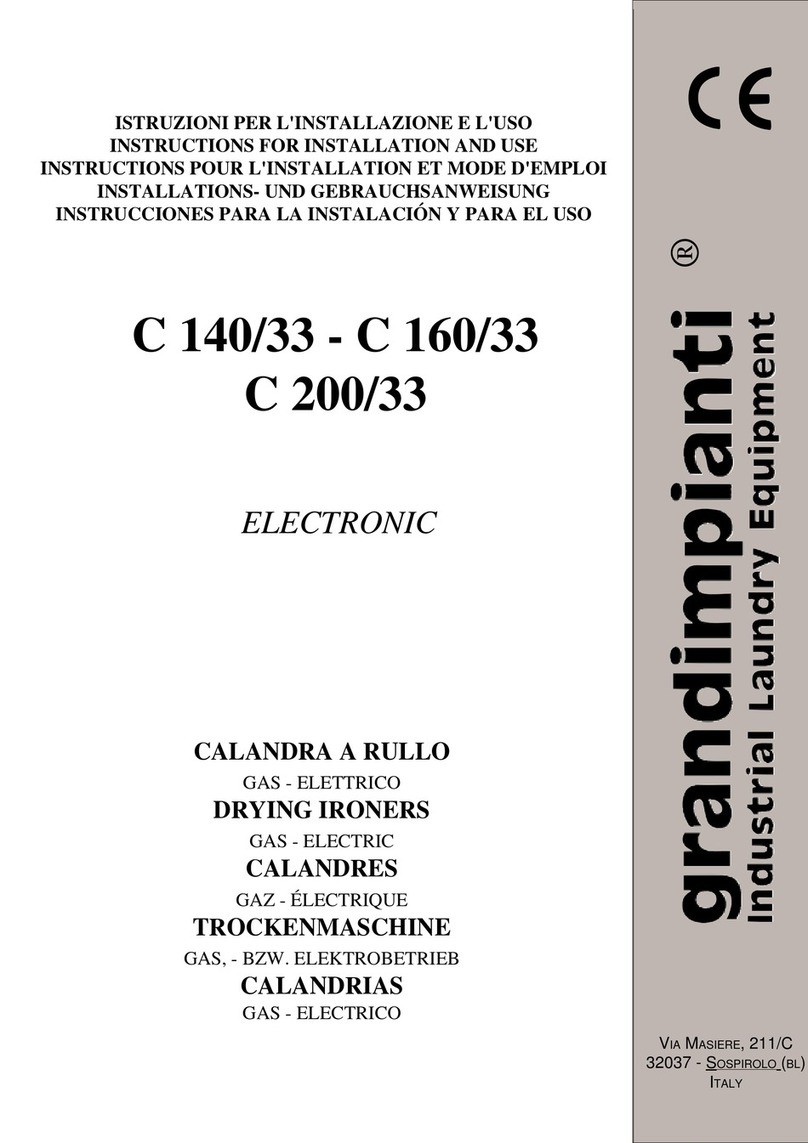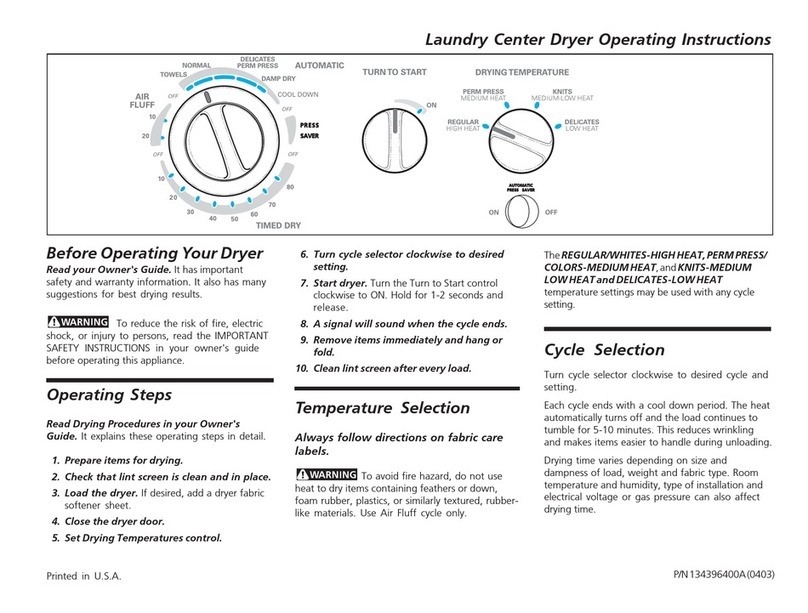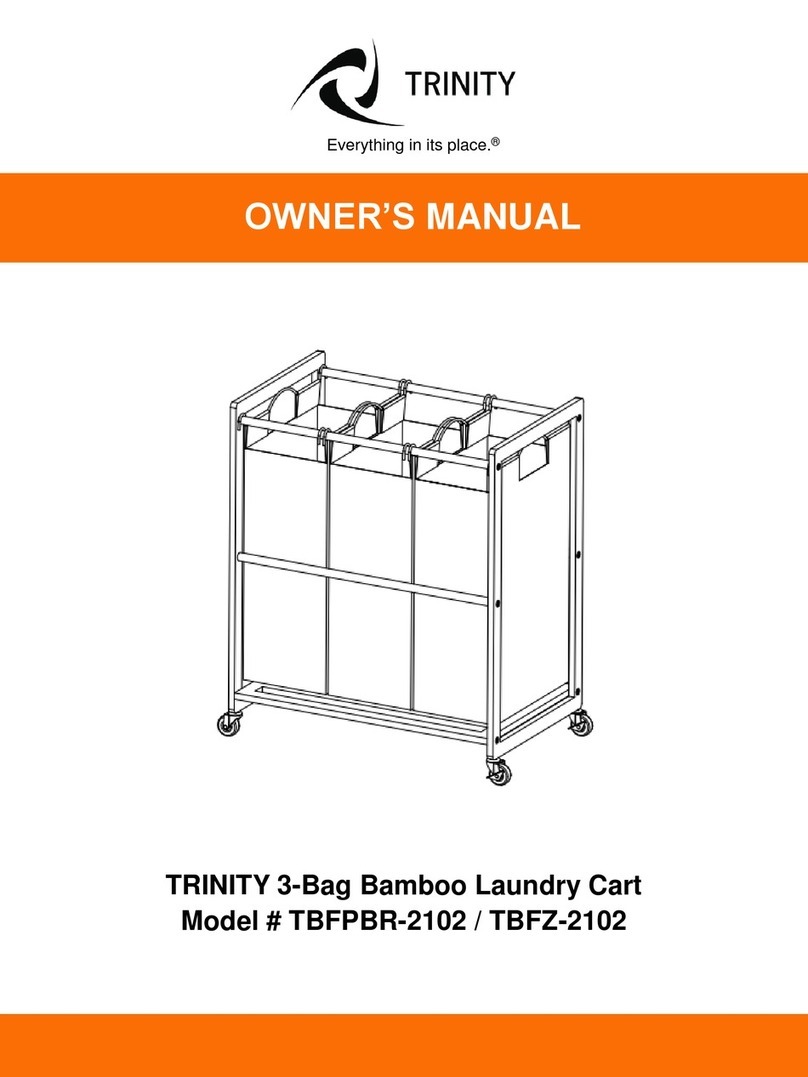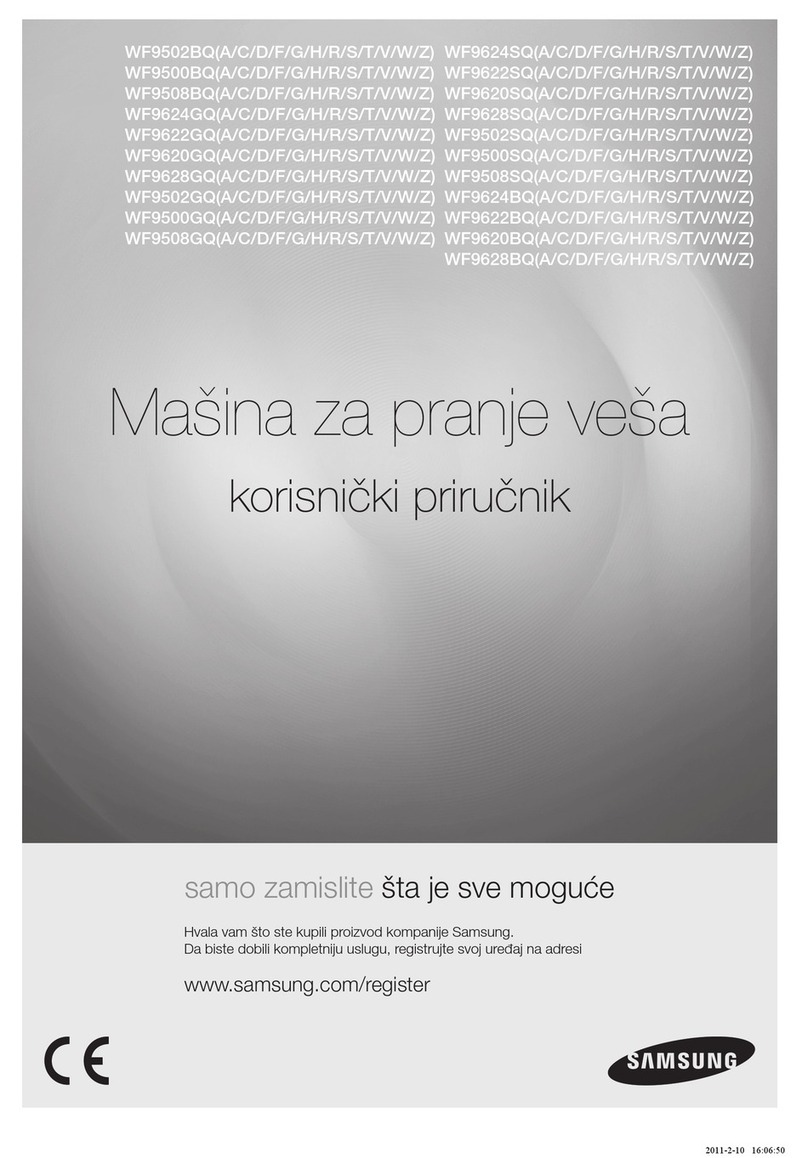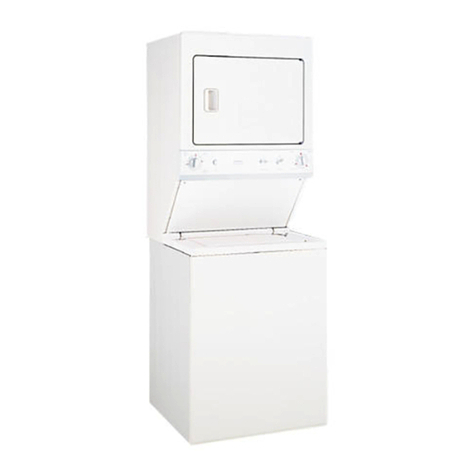grandimpianti GWH8 User manual

© All design models of Grandimpianti I.L.E. machines are registered
MA_GWH8-11-14-18-24-28_rev.00 02/2014
Idencaon. Product specicaon. Denions.
Preparaon of the product for use.
GWH8-11-14-18-24-28
Manufactured in compliance with 62079:2002-01 – EN 60204-1
Keep for future reference.

Attention!
• It shows a procedure or functioning condition, assembly or
testing that, if not complied with, may cause death or injury to
persons and animals, and damage to objects.
Attention!
• It shows a procedure or functioning condition, assembly or
testing that, if not complied with, may cause damage to or
destruction of equipment or components that are part of the
machine.
• It shows a procedure or functioning condition that, in addition
to being binding, can help you improve the manufacturing,
building or assembly of the components stated in the present
instructions.
1.1 KEY OF INDICATIONS.

Make sure that the delivered appliance corresponds with the model stated on the transport document or
invoice. The model is stated on the label positioned on the packaging, as well as on the rear closing panel
of the appliance.
Check that the model of the appliance stated on the label is the same described on the transport docu-
ment and/or invoice.
Model
Figure 2
Plate positioned on the
appliance.
Figure 2
Plate positioned on
the packaging.
The appliance version is always stated in the “model” eld stated on the packaging label and the appli-
ance, and is characterised as follows:
GWH XX Y/Y ZZZZ:
Code Value Description
HHigh spin appliance (extraction factor at maximum speed > 350 G).
XX 8, 11, 14, 18, 24, 28 Appliance capacity with 1/10 ratio
Y/Y E Appliance without heating, operation with hot water or with electric
heating.
S Appliance with direct steam heating.
E/S Appliance with mixed heating - Electric and direct Steam (with se-
lector switch).
IS Appliance with indirect steam heating.
ZZZZ COIN SELF Appliance intended for self-service use (coin operated, automatic
launderettes).
- - - Appliance intended for standard use.
1. IDENTIFICATION
1.1 APPLIANCE BRAND AND DESIGNATION OF THE TYPE
1.2 APPLIANCE VERSION

Manufacturer:
• Name: Grandimpianti Intelligent Laundry Equipment ALI S.p.A.
• Address: via Masiere 211/c, 32037 Sospirolo (BL) Italy
• Tel: +39 (0) 437 848 711
• Fax: +39 (0) 437 879 108
• E-mail: [email protected]
• WEB: www.grandimpianti.com
Supplier (importer):...........
Distributor:.......................
IMPORTER STAMP..............
DISTRIBUTOR STAMP.........
Attention!
• Before accepting the appliance from the carrier, check the
conditions of the packaging. If it shows evident external
damage, it means that the appliance may also have been
damaged. In this case, unpack the appliance in the presence
of the carrier and sign the relative transport document
applying the note "subject to conrmation".
• Any damage due to transport or incorrect storage cannot be
blamed on the appliance manufacturer.
• Make sure that the protruding parts of the appliance (e.g.
handle, porthole, disconnecting switch, dashboard, etc.)
have not been damaged.
1.3 NAME AND ADDRESS OF THE MANUFACTURER, SUPPLIER AND
DISTRIBUTOR
1.4 PICK-UP AND DELIVERY OF THE APPLIANCE BY THE CARRIER

Thank you for purchasing our appliance. We are sure you will be fully satised if you follow the indications
provided in this manual.
Please note that the text to make reference to for any claims or observations is the one in Italian.
Read the content of this manual thoroughly and keep it with the appliance. It must be easily available.
The recommendations and warnings contained in this manual cannot cover all possibilities; it is important to
use common sense, attention and caution. These are features that the manufacturer cannot add to the ma-
chine but must be a priority for the persons carrying out installation, maintenance and/or using the machine.
In the event of interventions on the appliance, the manufacturer recommends using original spare parts,
which must be ordered after consultation of the technical attachment.
The descriptions and illustrations contained in this manual are not binding; therefore, the company reserves
the right to update the publication, any time and without prior notice, and/or make any modications to
parts, components and accessories, if this is deemed necessary for improvement or to meet any construc-
tion or sales requirements.
Attention!
• Any person using this appliance must read this user manual.
2. PRODUCT SPECIFICATION
2.1 GENERAL FUNCTIONS AND RANGE OF APPLICATIONS, INTENDED USE
Attention!
• All other use that is not explicitly indicated must be
considered dangerous.
• The manufacturer cannot be held liable for any damage
deriving from use that is improper, incorrect or unreasonable
or, however, not stated in this manual.
• This appliance is not intended for use by children or persons
with reduced physical, sensory or mental capabilities, or
with lack of experience and knowledge, unless they are
supervised by a person responsible for their safety.
• Modications of the electric, electronic or mechanical
components and also to their relative positions can only be
made after written authorisation of the manufacturer.
• Children must not play with the appliance.

Follow recommendations below for transport and/or shipping:
• only use the original or equivalent pallet.
• use the manual or electric forklift with sufcient lifting capacity and fork length (see table and g.
3).
• check that the appliance can overcome all obstacles e.g. stairs, doors etc.
• Use the original packaging to ship the appliance
The product must be stored indoors and protected from the elements.
Figure 3 Appliance transport.
Appliance model Minimum fork length X (mm)
kg 8 1100
kg 11 1100
kg 14 1100
kg 18 1500
kg 24 1500
kg 28 1500
2.2 DIMENSIONS FOR TRANSPORT

2.3 DATA REGARDING POWER SUPPLY, GAS, WATER AND OTHER CONSUMABLES.
Appliance model IP degree of pro-
tection Description
kg 8
IP 24 D
Appliance not protected against mechanical
impacts.
Appliance protected against sprays of water
inclined up to 15°.
kg 11
kg 14
kg 18
kg 24
kg 28
Attention!
• The appliance is suitable only for INDOOR use.
• In the event of long periods in storage, leave the appliance
inside its original packaging, which guarantees excellent
protection.
• In the event of long downtime periods after use, follow the
instructions provided in paragraph 5.7.
2.4 IP CODE
2.5 ENVIRONMENTAL CONDITIONS AND OPERATION AND STORAGE LIMITS
(TRANSPORT)
CHARACTERISTICS kg 8 kg 11 kg 14 kg 18 kg 24 kg 28
Drum volume 75 litres 105 litres 135 litres 180 litres 240 litres 280 litres
Perf. of the drum 8% approximately 8% approximately 8% approximately 8% approximately 8% approximately 8% approximately
Number of
Programmes Unlimited
UR percentage 42-47% 45-50%
100% NOMINAL
CAPACITY kg 8 kg 11 kg 14 kg 18 kg 24 kg 28
Water per cycle litres 71.1 litres 85.9 litres 116.2 litres 154 litres 205.5 litres 245
Power consumption KWh1.563 KWh2.332 KWh3.125 KWh5.168 KWh6.450 KWh7.847
Cycle time 55min 55min 56min 56min 58min 60min
Detergents 100%
70% NOMINAL
CAPACITY kg 8 kg 11 kg 14 kg 18 kg 24 kg 28
Water per cycle litres 49.5 litres 60.2 litres 81.4 litres 110.7 litres 154 litres 172
Power consumption KWh1.158 KWh1.578 KWh1.998 KWh3.166 KWh3.713 KWh4.459
Cycle time 50min 51min 50min 50min 51min 52min
Detergents 70%
50% NOMINAL
CAPACITY kg 8 kg 11 kg 14 kg 18 kg 24 kg 28
Water per cycle litres 35.5 litres 43 litres 58.1 litres 90 litres 115 litres 142.5
Power consumption KWh0.888 KWh1.188 KWh1.488 KWh2.232 KWh2.713 KWh3.246
Cycle time 45min 46min 47min 46min 49min 50min
Detergents** 50% 50% 50% 50% 50% 50%

Minimum and maximum environmental conditions for operation.
* (only for appliances with this type of heating)
Minimum and maximum environmental conditions for storage and transport of the appliances..
Operating conditions
Model
Power
supply Water pressure
(KPa) Steam pressure* Room
temperature (°C)
Room
relative humidity
(%)
V Hz Min Max Min
(Kpa) Max
(KPa) Min Max Min Max
All models
-10 < V
< +10
of the
value
stated
on the
label
±1 com-
pared
to the
value
stated
on the
label
100 800 50 600 5 35
30
without
conden-
sation
90
without
conden-
sation
Model Operating conditions
All models
Room temperature (°C) Room relative humidity (%)
Min. Max. Min. Max.
0 55 0 without condensation 90 without condensa-
tion
In the event of failure and/or malfunction:
• disconnect the plug from the socket (if provided).
• lock the interlocked switch with a padlock
• close the loading gate valves (hard cold water, hard hot water, steam loading and steam condensate
drain if present)
• empty the dispenser from any detergent residues.
During use, cleaning and maintenance, pay attention not to access moving parts (motors, belts, fans) with
tools, much less with your hands.
In the event of accidents, the manufacturer will not be liable for damage to the operator or other persons
occurred during use, cleaning and maintenance of the appliance.
Do not open the detergent compartment during appliance operation (there could be splashes of boiling
water or detergent pushed by the pressure of the water).
The appliance has been designed to treat textiles according to the indications stated on the labels of the
garments. Only treat garments, household linens and fabrics for everyday use. Do not handle items
that have been in contact with inammable chemical materials. Hand-wash them rst anddry them
outdoors to make these substances evaporate.
Attention!
• This paragraph states all conditions and behaviour to
prevent dangerous conditions for persons, animals, objects
or the environment.
• Read what is stated thoroughly and keep this manual close
to the appliance for easy consultation!
• The appliance must only be used by trained persons.
2.6 INFORMATION RELATIVE TO SAFETY, SUMMARY (PERSONAL PROTECTION,
UNINTENDED USE)

USING ANY ELECTRIC OR ELECTRONIC APPLIANCE INVOLVES COMPLIANCE WITH
SEVERAL FUNDAMENTAL RULES.
To help you understand some of the more uncommon terms found in the manual, the denitions and
synonyms of some of the words used are provided below.
Appliance = product described in the manual (in this case, the washing machine).
User = person that:
• Is in charge of using the appliance.
• Has read and understood all pertinent parts of this manual.
• Is able to perform routine maintenance and clean the appliance.
• Is in charge of special maintenance of the appliance.
• Is qualied in the terms expressed below.
Weighing = phase of the washing cycle used to detect the weight (Kg) of the load inside the drum. This
phase consists of 2 distribution ramps without water in the tub.
Soaking = phase of the washing cycle that helps loosen dirt or stains that are difcult to remove.
Pre-washing = phase of the washing cycle that helps loosen and remove organic dirt.
Washing = main phase of the washing cycle required to remove dirt from the fabric.
Rinse = phase of the washing cycle required to remove the detergent and suspended dirt from the fabric.
Spin = phase of the washing cycle required to remove water and detergent from the fabric.
Unroll = nal phase of the washing cycle required to detach the laundry from the drum after the nal
spin.
Guard = part of an appliance used to provide protection by means of a physical barrier.
3. DEFINITIONS
In particular:
• Do not touch the appliance with wet or damp hands or feet.
• Do not use the appliance barefoot.
• Do not leave the appliance exposed to weather agents (rain, salt, sea salt etc.).
• Do not allow children or unable persons to use the appliance without suitable surveillance.
• Do not smoke close to the appliance during use.
• Do not remove or by-pass safety devices.
• Never use direct or indirect water jets on the appliance; pay attention not to install it close to areas
where this could happen.
• Do not touch water intake pipes even when the appliance is not running.
• Do not use the appliance to wash garments that carry the "hand wash only" or relative symbol care
label.
• Do not use hypochlorite (bleach), as it may oxidise some parts of the appliance (electric, electronic,
or metallic).
• Incorrect amounts of detergent or additives during the washing cycle may reduce the durability and
performance of the appliance.

Damage = physical injury, damage to health of persons, deterioration of assets or the environment.
Danger = potential source of damage.
Protection device = protection (different from a guard) which reduces risk (mechanical or electric de-
vices).
Risk = combination of the probability of damage occurring and of its seriousness.
Informed person = person suitably informed or monitored by a trained person to allow them
to perceive risks and prevent danger potentially created by the appliance operation or mainte-
nance..
Qualied technician = trained and experienced person able to perceive risks and prevent danger that
can derive from interaction with the appliance.
Description Symbol Description Symbol
At the end of its useful
life, the product must be
collected separately from
other waste.
Conformity marking on
the product in compli-
ance with EC Stand-
ards.
Attention, electrical hazard:
disconnect the appliance
from the mains before any
interventions.
Attention, crushing haz-
ard: Only use original
spare parts. Once re-
pairs and maintenance
have been completed,
restore all panels in
their original positions.
The bushings must be
greased every time it is
indicated on the display.
Attention, read the in-
structions!
Appliance safety earth con-
nection.
Attention, electrical
hazard: disconnect
the appliance from the
mains before any inter-
ventions.
Equipotential connection. Appliance earth connec-
tion.
Burn injury hazard. Burn injury hazard.
3.1 SYMBOLS (LABELS) APPLIED TO THE APPLIANCE

Description Symbol Description Symbol
Attention, electrical hazard,
400Vac voltage Room installation and
ventilation requisites.
Capacity of the fuses on
the appliance. Steam supply input.
High pressure steam.
Condensation leakage
from steam-powered
appliances.

Proceed as follows to transport and/or ship the appliance:
• Use the original pallet.
• Use a manual or electric forklift with sufcient lifting capacity and fork length.
• Check that the appliance can overcome all obstacles e.g. stairs, doors etc.
• Use the original packaging to ship the appliance.
• The product must be stored indoors and protected from the elements.
Figure 4Dimension of the forks for transport with forklift.
Attention!
• Check that the appliance has sufcient space according to the
installation layouts.
• See technical attachment relative to the layouts.
Appliance model Minimum fork length X (mm)
kg 8 1100
kg 11 1100
kg 14 1100
kg 18 1500
kg 24 1500
kg 28 1500
4. PREPARATION OF THE PRODUCT FOR USE
4.1 TRANSPORT AND STORAGE

Remove the packaging:
• Cut the straps that secure the box and lift it upwards.
• Once you have removed the external packaging, remove the nylon bag.
Attention!
• The following conditions must be veried before installation and
use of the appliance:
{ The transit areas must at least withstand the static load of
the appliance and of the transport mean.
{ The oor where the appliance is to be installed must
withstand the dynamic and static load produced by the
appliance.
{ Wooden oors are not allowed for installation of the
appliance.
{ Check that the electric consumption of the appliance is
lower than that supplied by the electric company.
{ Check that the steam and water pressure available (for
appliances provided with this type of heating) are within
the accepted values.
Attention!
• Store the packaging material in a safe place, which must not be
accessible to unauthorised persons.
Model Dynamic load (kN) Electric consumption Kw
(optional value) Max. water pressure
(KPa) Max. steam pressure
(KPa)
kg 8 1.9 ± 0.5 at 19.4 Hz 6-(9)
600 600
kg 11 2.2 ± 0.5 at 17.9 Hz 9-(16/12)
kg 14 2.7 ± 0.5 at 17.9 Hz 12-(9)
kg 18 4.0 ± 0.5 at 16.3 Hz 18-(12)
kg 24 4.6 ± 0.5 at 16.3 Hz 18
kg 28 5.0 ± 0.5 at 15.25 Hz 22
4.2 SAFETY PRECAUTIONS BEFORE USE
4.3 UNPACKING

The following are the materials used for packaging:
• Nylon (for the bag).
• Cardboard for the box
Take the packaging materials to a waste collection and disposal centre in the event it must be disposed of.
Correct separate collection of the packing helps prevent possible negative effects to the environment and
favours the recycling of materials that make up the packaging.
Illegal disposal of the packaging leads to the application of administrative sanctions provided by law.
Refer to the WEEE European Directive regarding the recovery of parts (only for countries that are part of
the European Community).
To dismantle the single parts and take them to a differentiated collection centre, refer to the catalogu-
ing groups of the individual parts. Ifrequired, the cataloguing groups can be found on the website: www.
euwas.org
Once you have removed the packaging, check the data stated on the appliance identication plate.
4.4 SAFE DISPOSAL OF PACKAGING MATERIALS
4.5 PREPARATION WORK BEFORE INSTALLATION
Model Company name
Motor power
Total power
IP degree of protection
of the appliance
Appliance type
approvals.
Serial number
Power Supply Voltage
Year and month of
manufacture
Total electric absorption
Figure 6 Identication plate found
on the last page of the manual and
on the rear panel of the appliance.

Model Company name
Net weight and volume
of the packaging
Inspector's signature
Power supply voltage
and frequency
Serial number
Gross weight and di-
mensions
Signature conrming
quality checks per-
formed
Figure 7 Identication plate
located on the appliance
packaging.
Attention!
• Do not power the appliances with voltages and frequencies
outside of the values stated.
• Check that the electric power supply data correspond with
the electric energy supply values.
• Remove the upper panel by loosening the two rear M6 torx head screws and the two upper M6 hex-
head screws. Once you have removed these four screws, slide the panel towards the back of the
appliance and remove it;
• Remove the front service panel (in all models it is secured with two M6 torx head screws on the
bottom and 2 M4 torx head screws on the top). The electronic control remains in its position after
you have removed the front panel. Pay attention to the electrical connection of the emergency stop
button. It must be disconnected to fully remove the front panel;
• Remove the lower rear panel in all the models (M6 torx screws);
• Remove the centre rear panel where the electrical connections will be made;
• Remove the pallet, which is secured with 4 bolts in the same holes to be used to secure the
appliance to the oor using the provided dowels.
4.6 INSTALLATION AND ASSEMBLY
Attention!
• The appliances must be positioned on a at, levelled and solid
surface.
• Refer to the technical attachment regarding the distances required
between the appliances and between these and the construction
work.
• The appliance must be secured with the specic dowels if the oor is
wet or damp.
• Check that the pressure - weight is equally distributed on the entire
support surface.
4.6.1 CONSTRUCTION WORK

Depending on the type of oor, the appliance may need to be secured to the oor: the appliances must be
secured with the provided dowels. If this indication is not followed, the appliance may move, causing dam-
age to persons, animals, or objects.
To secure the appliance to the oor, make holes of a suitable diameter for the provided dowels. Always
make sure that the appliance is levelled.
In the event the appliance must be moved, level and secure it again.
1. M8 screw
2. M8 safety nut
3. M8 nut
4. Machine frame
5. Washer
6. Raised frame (if provided)
7. Concrete oor
8. Anchoring bolt
9. Supplied dowels
The appliances have one hot water inlet (max 90°C) and two cold water inlets (for soft and hard water).
See paragraph 3.3
The table below allows you to determine the hardness of water according to the most common unit of
measurements .
Place wall gate valves at a distance that must not exceed the length of the provided pipes.
Classication mmol/dm3 °dH (German de-
grees) °fH (French de-
grees) English degrees
Soft 0→1.25 0→7 0→12 0→8.75
Average 1.25→2.5 7→14 12→25 8.75→17.5
Hard 2.5→3.75 14→21 25→37 17.5→26.3
Very hard >3.75 >21 >37 >26.3
Attention!
• In the event hot water or soft cold water is not available, provide one
or two T-connections to always supply all the inlets of the appliance.
4.6.2 WATER CONNECTION
Attention!
• Do not connect the water inlets with rigid pipes.
• Use the supplied pipes only.
• Rigid pipes can cause problems due to the vibrations generated by the
appliance during normal operation.
• The water supply connections of the appliances are made of plastic.
Follow the procedure below to tighten the hose ring-nut correctly.
{ Manually tighten the nut until it locks.
{ Make a quarter turn with a xed spanner.
• At the end of the assembly operation, make sure that there are no
bottlenecks or crushed parts in the used pipes.

Appliances with steam heating have an M ¾” threaded inlet specic for dry saturated steam.
In the event the appliance is requested with indirect steam heating, there is an M ¾” threaded connection
for the collection/recovery of condensation.
The inlet steam pressure must range between 50Kpa and 600KPa.
Refer to the gures found in the last pages of the manual for the steam inlets and condensate collection.
Attention!
• To check the tightening of the ring nuts of the load pipes and of the
lters (where provided), open the water gate valve slowly and check
for the presence of water leaks.
• Should leaks be detected, close the ring nut and check again.
4.6.3 STEAM AND CONDENSATE CONNECTION (ONLY FOR APPLIANCES WITH
STEAM HEATING)
To obtain optimal performance, pressure should range between 400KPa and 600KPa.
Attention!
• Contact the manufacturer or the area dealer for pressures higher than
the values indicated.
• Cover the provided steam inlet hose and/or the condensate outlet
hose with the teon sheath supplied in order to prevent the operator
from coming into contact with the steam and condensate hoses, which
are normally very hot and can cause burns.
• Use material capable of resisting both the supply pressure (max
600KPa) and to a temperature of 170°C to install the steam intake
pipes and the condensate recovery. The manufacturer is not liable for
failure to comply with these parameters.
• At the end of the assembly operation, make sure that there are no
bottlenecks in the pipes used.
Provide both the connections (steam and condensate optional outlet) with two gate valves to disconnect
the appliance in the event of maintenance or failure.
Insert the provided F/F ¾“ threaded lter between the steam gate valve and the appliance inlet. This l-
ter stops the impurities and must be cleaned at least on a monthly basis. In the event the steam distribu-
tion system is new, it is likely that the mechanical lter needs to be cleaned even on a daily basis during
the rst days of operation.
If the steam appliance is subject to inspections by local or national bodies (ISPESL for Italy), always have
the relative documentation available in the locations in which the appliance is installed.

The appliances are equipped with a connection for the pipe for the water drained during the washing
process. A 3” elbow-joint and two metal strips are also provided to connect the appliance discharge to the
sewer collection service. Refer to the gure to identify the drain pipe tting.
Make sure that the distance between the appliance drain connection and the oor drain is not greater than
the supplied elbow-joint length.
Water is drained via a motorised valve, which remains open if no voltage is available.
Some special versions are equipped with a second drain to recover the water of some washing phases.
Follow the special instructions provided with the special version.
4.6.4 DISCHARGE PIPE CONNECTION
Earthing techniques.
There are different types of earth systems on the market, but for all systems, the objectives are identical:
• Limit the potential of the active wires compared to the earth in normal operating mode.
• In the event of an isolation defect, limit the voltages between the masses and the earth.
• Allow the intervention of the protection devices in order to eliminate the earth fault.
• Limit the raising of the potential due to faults resulting from the medium voltage network.
• Limit the raising of the potential when the atmospheric discharge affects the installation or the
power supply network.
Some examples.
Attention!
• The drain duct must always be lower than the appliance outlet and
its diameter must not be lower than that of the supply pipe.
• The drain duct must resist temperatures of 90 °C.
• Place a syphon between the provided pipe and the drain duct.
• Make sure there are no bottlenecks.
Attention!
• Installation must be carried out according to the manufacturer's
instructions by qualied and certied personnel, in compliance
with Standards in force regarding electric systems both at national
and local level.
• Incorrect installation can cause injury to persons and animals and
damage to objects and the environment in general, for which the
manufacturer is not liable.
4.6.5 ELECTRIC CONNECTIONS

NATION LV public distribution
networks (neutral point) User systems powered at
low voltage. Specic earth system.
GERMANY TN-C TN-C and TT yes
AUSTRALIA TN-C TN-C yes
JAPAN TT TT yes
UNITED KINGDOM TN-C TN-C or TN-S NO
IRELAND TN TT yes
ITALY TT TT yes
BELGIUM TT TT yes
SWITZERLAND TN TN-C or TN-S yes
FRANCE TT TT yes
CHINA TT TT yes
SPAIN TT TT yes
PORTUGAL TT TT yes
NORWAY IT IT NO
There is a clamp on the rear part of the appliance for the connection of the earth conductor, which must be
performed in compliance with the Laws in force.
The manufacturer declines any liability for failure to comply with this accident-prevention standard.
In this respect, identify the symbol provided below.
This clamp must be connected to the same clamp of the other appliances present in the vicinity and must
be then connected to the earth connection via a protective earth circuit alternative to the earth wire sup-
plied with the socket.
Before placing the cable inside the appliance, make sure that the cable bend
is lower than the appliance inlet or clamp to prevent condensation drops on the cable from coming into
contact with the electric connections.
Power the appliance in compliance with its plate data and
with the available distribution system.
Use the cable gland mounted on the rear panel of the appli-
ance to insert the power supply cable and block the cable,
after having connected the cables to the isolating switch sup-
plied with the appliance.
Attention!
• The appliance described in this manual is set-up for a TT earth sys-
tem.
• Certication of the system must be made by a qualied technician,
who veries and certies its correct design and operation.
• For appliances with steam supply, make sure that the electric con-
nection cable cannot come into contact with the steam supply pipe or
condensate collection/recovery pipe.

The drum is blocked with two brackets on the front side and with other two brackets on the rear to prevent
damaging the appliance structure during transport.
To access these brackets, take off the panels as indicated previously and remove the brackets highlighted
with a general danger triangular sticker.
Attention!
• Disassemble the transport bracket before starting the appliance.
• Starting the appliance with the transport bracket still mounted can
damage the appliance and cause injuries to personnel.
• Remove only the transport brackets.
• Do not transport the appliance without the transport brackets.
4.7 REMOVAL OF THE TRANSPORT BRACKETS
For transport reasons, the appliance is blocked to prevent any movement of the washing unit.
Once you have removed the transport brackets, reassemble all the previously removed panels.
Store the transport brackets for any future transport of the appliance.
Attention!
• DO NOT start the appliance or adjust the imbalance micro
switch before having removed the brackets.
Once the transport brackets have been removed from the appliance and it has been installed on a levelled
surface, the imbalance micro switch must be adjusted.
This safety device prevents excessive imbalance of the drum-tub unit during not perfectly balanced spin
phases.
Adjust the device as indicated in the gure to guarantee proper operation of the appliance. The elastic rod
that detects any imbalance of the drum-tub unit must be positioned in the centre and lower than the window
that determines the maximum excursion.
Attention!
• To carry out this operation, the drum must be empty and the
appliance must be installed in its denitive position.
• Adjust this device every time the appliance must be moved.
4.8 ADJUSTING THE IMBALANCE MICRO SWITCH
This manual suits for next models
5
Table of contents
Other grandimpianti Laundry Appliance manuals
Popular Laundry Appliance manuals by other brands

Tricity Bendix
Tricity Bendix 73188 Operating and installation instructions
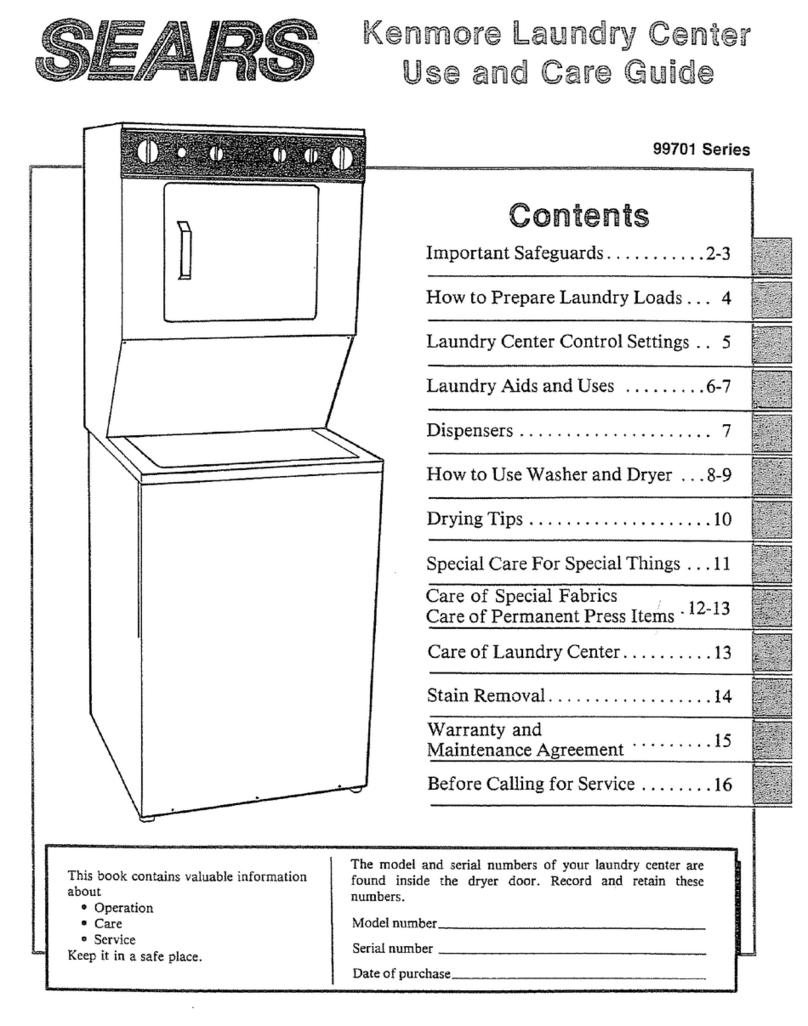
Kenmore
Kenmore Sears 99701 Series Laundry center Use and care guide
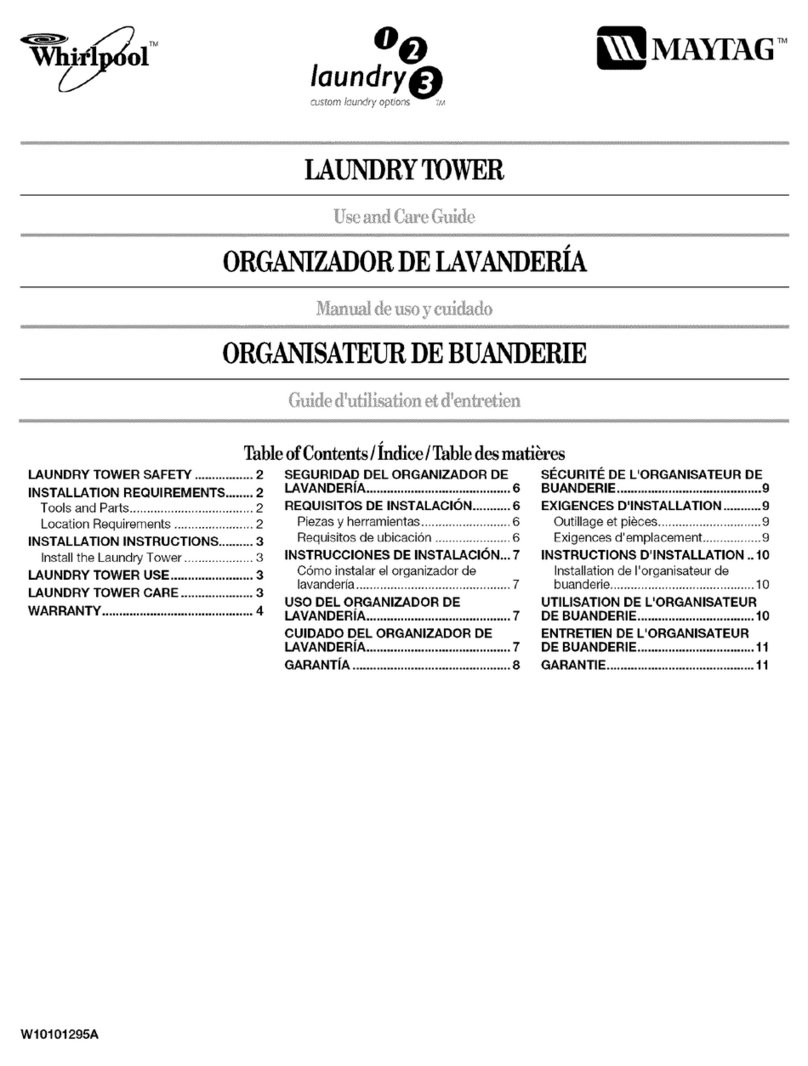
Whirlpool
Whirlpool XVP9000TA0 Use and care guide

Frigidaire
Frigidaire GLGT1142CS1 Wiring diagram
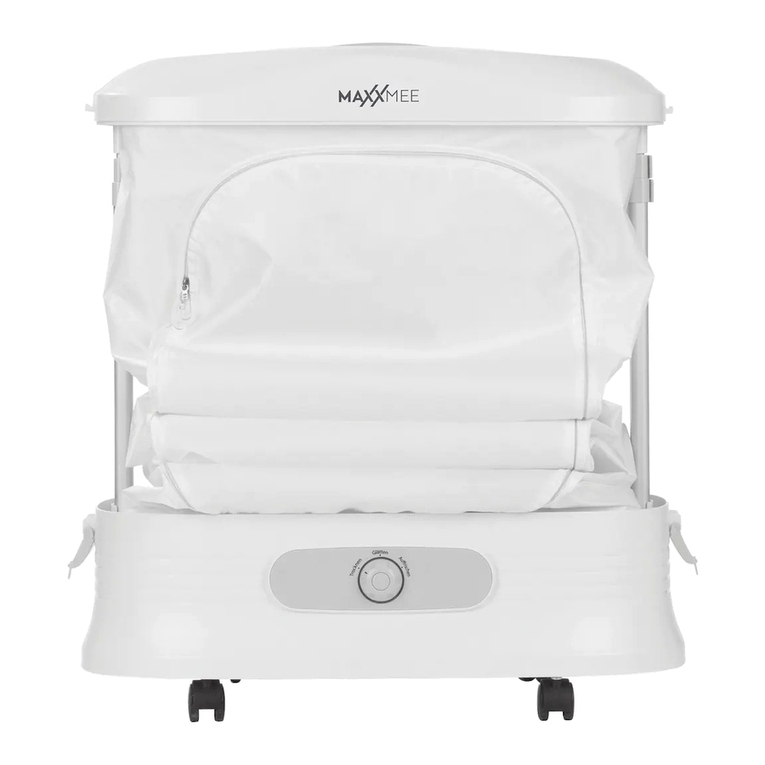
MAXXMEE
MAXXMEE KB-6005 operating instructions
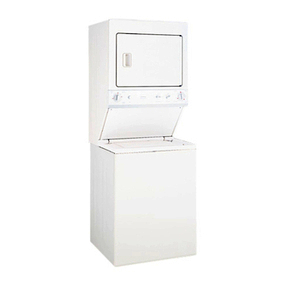
GE
GE Spacemaker Laundry WSM27TH Use and care guide

